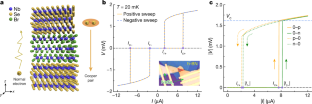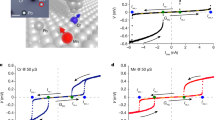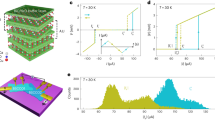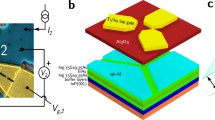Abstract
The superconducting analogue to the semiconducting diode, the Josephson diode, has long been sought with multiple avenues to realization being proposed by theorists1,2,3. Showing magnetic-field-free, single-directional superconductivity with Josephson coupling, it would serve as the building block for next-generation superconducting circuit technology. Here we realized the Josephson diode by fabricating an inversion symmetry breaking van der Waals heterostructure of NbSe2/Nb3Br8/NbSe2. We demonstrate that even without a magnetic field, the junction can be superconducting with a positive current while being resistive with a negative current. The ΔIc behaviour (the difference between positive and negative critical currents) with magnetic field is symmetric and Josephson coupling is proved through the Fraunhofer pattern. Also, stable half-wave rectification of a square-wave excitation was achieved with a very low switching current density, high rectification ratio and high robustness. This non-reciprocal behaviour strongly violates the known Josephson relations and opens the door to discover new mechanisms and physical phenomena through integration of quantum materials with Josephson junctions, and provides new avenues for superconducting quantum devices.
This is a preview of subscription content, access via your institution
Access options
Access Nature and 54 other Nature Portfolio journals
Get Nature+, our best-value online-access subscription
$29.99 / 30 days
cancel any time
Subscribe to this journal
Receive 51 print issues and online access
$199.00 per year
only $3.90 per issue
Buy this article
- Purchase on Springer Link
- Instant access to full article PDF
Prices may be subject to local taxes which are calculated during checkout




Similar content being viewed by others
Data availability
The data that support the findings of this study are available from the corresponding authors upon reasonable request.
References
Misaki, K. & Nagaosa, N. Theory of the nonreciprocal Josephson effect. Phys. Rev. B 103, 245302 (2021).
Hu, J., Wu, C. & Dai, X. Proposed design of a Josephson diode. Phys. Rev. Lett. 99, 067004 (2007).
Chen, C.-Z. et al. Asymmetric Josephson effect in inversion symmetry breaking topological materials. Phys. Rev. B 98, 075430 (2018).
Tokura, Y. & Nagaosa, N. Non-reciprocal responses from non-centrosymmetric quantum materials. Nat. Commun. 9, 3740 (2018).
Fruchart, M., Hanai, R., Littlewood, P. B. & Vitelli, V. Non-reciprocal phase transitions. Nature 592, 363–369 (2021).
Akamatsu, T. et al. A van der Waals interface that creates in-plane polarization and a spontaneous photovoltaic effect. Science 372, 68–72 (2021).
Sze, S. M. & Lee, M.-K. Semiconductor Devices: Physics and Technology 3rd edn (Wiley, 2012).
Ando, F. et al. Observation of superconducting diode effect. Nature 584, 373–376 (2020).
Wakatsuki, R. et al. Non-reciprocal charge transport in noncentrosymmetric superconductors. Sci. Adv. 3, e1602390 (2017).
Zhang, E. et al. Nonreciprocal superconducting NbSe2 antenna. Nat. Commun. 11, 5634 (2020).
Baumgartner, C. et al. Supercurrent rectification and magnetochiral effects in symmetric Josephson junctions. Nat. Nanotechnol. 17, 39–44 (2022).
Yuan, N. F. Q. & Fu, L. Supercurrent diode effect and finite momentum superconductivity. Preprint at https://arxiv.org/abs/2106.01909 (2021).
Daido, A., Ikeda, Y. & Yanase, Y. Intrinsic superconducting diode effect. Phys. Rev. Lett. 128, 037001 (2022).
Ideue, T. et al. Bulk rectification effect in a polar semiconductor. Nat. Phys. 13, 578–583 (2017).
Ideue, T., Koshikawa, S., Namiki, H., Sasagawa, T. & Iwasa, Y. Giant nonreciprocal magnetotransport in bulk trigonal superconductor PbTaSe2. Phys. Rev. Res. 2, 042046(R) (2020).
Wang, Y. et al. Gigantic magnetochiral anisotropy in the topological semimetal ZrTe5. Preprint at https://arxiv.org/abs/2011.03329 (2021).
Likharev, K. K. Dynamics of Josephson Junctions and Circuits (Gordon and Breach Science Publishers, 1986).
Likharev, K. K. Superconducting weak links. Rev. Mod. Phys. 51, 101–159 (1979).
Dubos, P. et al. Josephson critical current in a long mesoscopic S-N-S junction. Phys. Rev. B 63, 064502 (2001).
Golubov, A. A., Kupriyanov, M. Y. & Il’ichev, E. The current-phase relation in Josephson junctions. Rev. Mod. Phys. 76, 411–469 (2004).
Lee, G.-H. et al. Graphene-based Josephson junction microwave bolometer. Nature 586, 42–46 (2020).
Walsh, E. D. et al. Josephson junction infrared single-photon detector. Science 372, 409–412 (2021).
Clarke, J. & Wilhelm, F. K. Superconducting quantum bits. Nature 453, 1031–1042 (2008).
Likharev, K. K. & Semenov, V. K. RSFQ logic/memory family: a new Josephson-junction technology for sub-terahertz-clock-frequency digital systems. IEEE Trans. Appl. Supercond. 1, 3–28 (1991).
Devoret, M. H. & Schoelkopf, R. J. Superconducting circuits for quantum information: an outlook. Science 339, 1169–1174 (2013).
Jiang, J. et al. Exploration of new ferromagnetic, semiconducting and biocompatible Nb3X8 (X = Cl, Br or I) monolayers with considerable visible and infrared light absorption. Nanoscale 9, 2992–3001 (2017).
Pasco, C. M., El Baggari, I., Bianco, E., Kourkoutis, L. F. & McQueen, T. M. Tunable magnetic transition to a singlet ground state in a 2D van der Waals layered trimerized Kagome magnet. ACS Nano 13, 9457–9463 (2019).
Yoon, J. et al. Anomalous thickness-dependent electrical conductivity in van der Waals layered transition metal halide, Nb3Cl8. J. Phys. Condens. Matter 32, 304004 (2020).
Haraguchi, Y. et al. Magnetic-nonmagnetic phase transition with interlayer charge disproportionation of Nb3 trimers in the cluster compound Nb3Cl8. Inorg. Chem. 56, 3483–3488 (2017).
Sheckelton, J. P., Plumb, K. W., Trump, B. A., Broholm, C. L. & McQueen, T. M. Rearrangement of van der Waals stacking and formation of a singlet state at T = 90 K in a cluster magnet. Inorg. Chem. Front. 4, 481–490 (2017).
Castellanos-Gomez, A. et al. Deterministic transfer of two-dimensional materials by all-dry viscoelastic stamping. 2D Mater. 1, 011002 (2014).
Xi, X. et al. Ising pairing in superconducting NbSe2 atomic layers. Nat. Phys. 12, 139–143 (2015).
Kleiner, R., Koelle, D., Ludwig, F. & Clarke, J. Superconducting quantum interference devices: state of the art and applications. Proc. IEEE 92, 1534–1548 (2004).
Yabuki, N. et al. Supercurrent in van der Waals Josephson junction. Nat. Commun. 7, 10616 (2016).
Kim, M. et al. Strong proximity Josephson coupling in vertically stacked NbSe2-graphene-NbSe2 van der Waals junctions. Nano Lett. 17, 6125–6130 (2017).
Kitamura, S., Nagaosa, N. & Morimoto, T. Nonreciprocal Landau–Zener tunneling. Commun. Phys. 3, 63 (2020).
Xu, Y. et al. Filling-enforced obstructed atomic insulators. Preprint at https://arxiv.org/abs/2106.10276 (2021).
Xu, Y. et al. Three-dimensional real space invariants, obstructed atomic insulators and a new principle for active catalytic sites. Preprint at https://arxiv.org/abs/2111.02433 (2021).
Song, T. et al. Giant tunneling magnetoresistance in spin-filter van der Waals heterostructures. Science 360, 1214–1218 (2018).
Wang, Z. et al. Very large tunneling magnetoresistance in layered magnetic semiconductor CrI3. Nat. Commun. 9, 2516 (2018).
Krasnov, V. M., Oboznov, V. A. & Pedersen, N. F. Fluxon dynamics in long Josephson junctions in the presence of a temperature gradient or spatial nonuniformity. Phys. Rev. B 55, 14486–14498 (1997).
Goldman, A. M. & Kreisman, P. J. Meissner effect and vortex penetration in Josephson junctions. Phys. Rev. 164, 544–547 (1967).
Kononov, A. et al. One-dimensional edge transport in few-layer WTe2. Nano Lett. 20, 4228–4233 (2020).
Watanabe, N. et al. The shape dependency of two-dimensional magnetic field dependence of a Josephson junction. J. Appl. Phys. 103, 07C707 (2008).
Vergniory, M. G. et al. A complete catalogue of high-quality topological materials. Nature 566, 480–485 (2019).
Bradlyn, B. et al. Topological quantum chemistry. Nature 547, 298–305 (2017).
Acknowledgements
We thank J. Song, G.-H. Lee and Y. Wang for valuable discussions. We thank P. Wang for support during preparation of Fig. 1a. M.N.A. acknowledges that this research was principally supported by the Alexander von Humboldt Foundation Sofia Kovalevskaja Award, the German Federal Ministry of Education and Research’s MINERVA ARCHES Award, the Max Planck Society and Delft University of Technology. Y.-J.Z. acknowledges the Shenzhen Science and Technology Project under grant no. JCYJ20180507182246321. S.S.P.P. acknowledges the European Research Council under the European Union’s Horizon 2020 research and innovation programme (grant agreement no. 670166), Deutsche Forschungsgemeinschaft (DFG, German Research Foundation)—project number 314790414 and Alexander von Humboldt Foundation in the framework of the Alexander von Humboldt Professorship endowed by the Federal Ministry of Education and Research. T.M. acknowledges the David and Lucile Packard Foundation and the Johns Hopkins University Catalyst Award.
Author information
Authors and Affiliations
Contributions
H.W. and M.N.A. conceived and designed the study. C.P. grew the samples. H.W. and Y.W. fabricated the devices. H.W., Y.W., P.K.S. and U.F. performed the transport measurements. H.W. and Y.W. carried out the data analysis. Y.X. provided theoretical support and discussion. Y.-J.Z. and S.S.P.P. provided facility and instrument support. T.M. and M.N.A. are the principal investigators. All authors contributed to the preparation of the manuscript.
Corresponding authors
Ethics declarations
Competing interests
The authors declare no competing interests.
Peer review
Peer review information
Nature thanks Kanda Akinobu and the other, anonymous, reviewer(s) for their contribution to the peer review of this work. Peer reviewer reports are available.
Additional information
Publisher’s note Springer Nature remains neutral with regard to jurisdictional claims in published maps and institutional affiliations.
Extended data figures and tables
Extended Data Fig. 1 Temperature dependent resistance and V-I curves of the Josephson diode.
a, Nb3Br8: crystal structure and inversion center locations. b, Resistance versus temperature measured using an a.c. current of 100 nA. Inset shows the enlarged plot near the superconducting transition of 6.6 K. c, V-I curves with positive sweep measured at different temperatures showing nonlinear behavior appearing below Tc.
Extended Data Fig. 2 V-I curves and half-wave rectification at different temperatures.
a, Positive sweep V-I curve measured at 0.9 K. Both ΔIc and ΔIr are visible. b, Half-wave rectification measured at 0.9 K with an applied current of 7.6 μA at 0.1 Hz. The red dotted lines are the zero lines, showing that junction is in the superconducting state with negative current and switches to the normal state with positive current. c, Positive sweep V-I curve measured at 3.86 K. ΔIc is still visible, while the hysteresis is almost completely suppressed. d, Half-wave rectification measured at 3.86 K with an applied current of 5.14 μA at 0.1 Hz. The red dotted lines are the zero lines. Imperfect rectification is evident with some punch-through error, probably due to thermal fluctuation.
Extended Data Fig. 3 V-I curves with 0-p and 0-n branches measured at different magnetic fields.
Solid lines are 0-n branches (where Ic- was extracted) and dotted lines are 0-p branches (where Ic+ was extracted) corresponding to Fig. 3. ΔIc almost ‘turns off’ at 35 mT.
Extended Data Fig. 4 Sweep-up magnetic field dependence of Ic and ΔIc.
a, Ic+ (orange dots) and |Ic-| (green dots) obtained from the 0-p and 0-n branches of the positive sweep as a function of applied magnetic field. The in-plane magnetic field was swept from negative to positive. b, ΔIc as a function of magnetic field. Inset shows ΔIc as a function of |Ic-| from modulation of magnetic field with the diode effect ‘turning off’ below 2.1 μA. These sweep-up results are nearly identical with the sweep-down results shown in Fig. 3.
Extended Data Fig. 5 Magnetoresistance of NbSe2/Nb3Br8/NbSe2 and FLG/Nb3Br8/FLG heterostructures.
a, Sweep-up and sweep-down magnetoresistances of NbSe2/Nb3Br8/NbSe2 (device 1) with OOP magnetic field at 10 K (above Tc of NbSe2). b, Sweep-up and sweep-down magnetoresistances of device 1 with in-plane magnetic field at 10 K. c, Sweep-up and sweep-down magnetoresistance of FLG/Nb3Br8/FLG (device 6) with OOP magnetic field at 2 K.
Extended Data Fig. 6 Field-free Josephson diode effect of a NbSe2/four-layer Nb3Br8/NbSe2 device.
a, Ic+ and |Ic-|as a function of magnetic field at 20 mK in NbSe2/four-layer Nb3Br8/NbSe2 junction (device 3). b, ΔIc as a function of magnetic field of device 3. c, First harmonic (Rω) and second-harmonic resistances (R2ω) as a function of magnetic field measured at 20 mK with an applied current of 4 μA of device 3.
Extended Data Fig. 7 Field-induced superconducting diode effect in NbSe2/NbSe2 and NbSe2/FLG/NbSe2 heterostructures.
a, V-I curve of NbSe2/NbSe2 junction (device 4) measured at 2 K and 0 T. b, Ic+ and |Ic-| as a function of magnetic field of device 4 at 2 K. c, ∆Ic as a function of magnetic field of device 4. d, ∆Ic as a function of magnetic field of NbSe2/FLG/NbSe2 junction (device 5) measured at 2 K, inset shows the corresponding Ic+ and |Ic-|.
Extended Data Fig. 8 Field-induced superconducting diode effect in NbSe2/NbSe2 heterostructures with a lower critical current.
a, Ic+ and |Ic-| as a function of applied magnetic field of NbSe2/NbSe2 junction (device 7). b, ∆Ic as a function of magnetic field of device 7.
Extended Data Fig. 9 Fraunhofer patterns of NbSe2/Nb3Br8/NbSe2 heterostructures.
a, Fraunhofer pattern of device 1 with sweep-down magnetic field. b, Fraunhofer pattern of device 2. c, ∆Ic as a function of applied magnetic field of device 2 measured at 20 mK, inset shows the corresponding Ic+ and |Ic-|.
Extended Data Fig. 10 Obstructed atomic insulator property of Nb3Br8.
a, charge density distribution in a Nb3Br8 unit cell, the yellow/blue lobes indicate the charge density. b, charge density distribution as a function of unit cell location. Note the charge density does not drop to near zero in every other van der Waals gap.
Supplementary information
Rights and permissions
About this article
Cite this article
Wu, H., Wang, Y., Xu, Y. et al. The field-free Josephson diode in a van der Waals heterostructure. Nature 604, 653–656 (2022). https://doi.org/10.1038/s41586-022-04504-8
Received:
Accepted:
Published:
Issue Date:
DOI: https://doi.org/10.1038/s41586-022-04504-8
This article is cited by
-
Intrinsic supercurrent non-reciprocity coupled to the crystal structure of a van der Waals Josephson barrier
Nature Communications (2024)
-
High-temperature Josephson diode
Nature Materials (2024)
-
Superconductivity in unconventional metals
npj Computational Materials (2024)
-
Superconducting diode effect sign change in epitaxial Al-InAs Josephson junctions
Communications Physics (2024)
-
Nb3Cl8: a prototypical layered Mott-Hubbard insulator
npj Quantum Materials (2024)
Comments
By submitting a comment you agree to abide by our Terms and Community Guidelines. If you find something abusive or that does not comply with our terms or guidelines please flag it as inappropriate.



